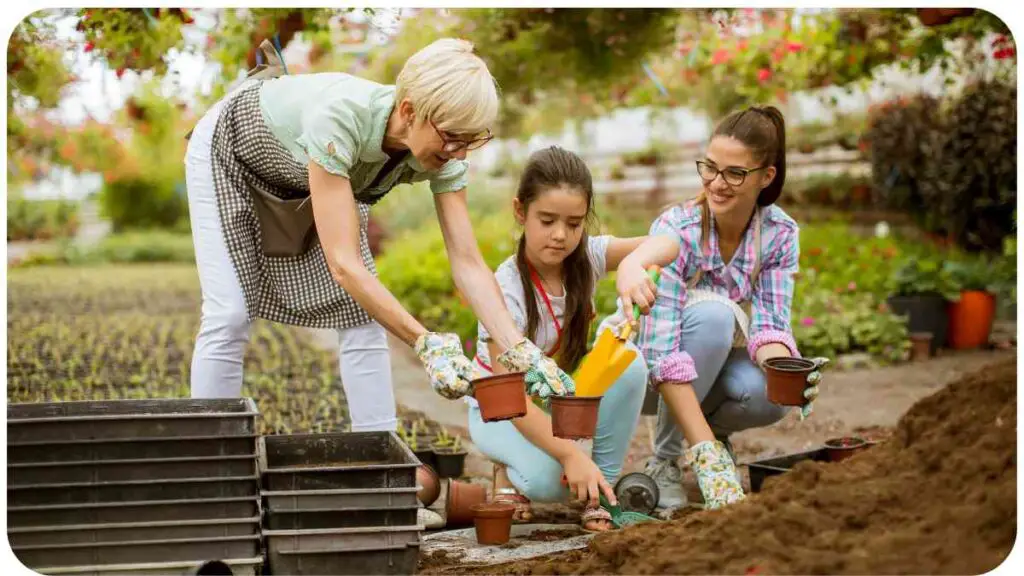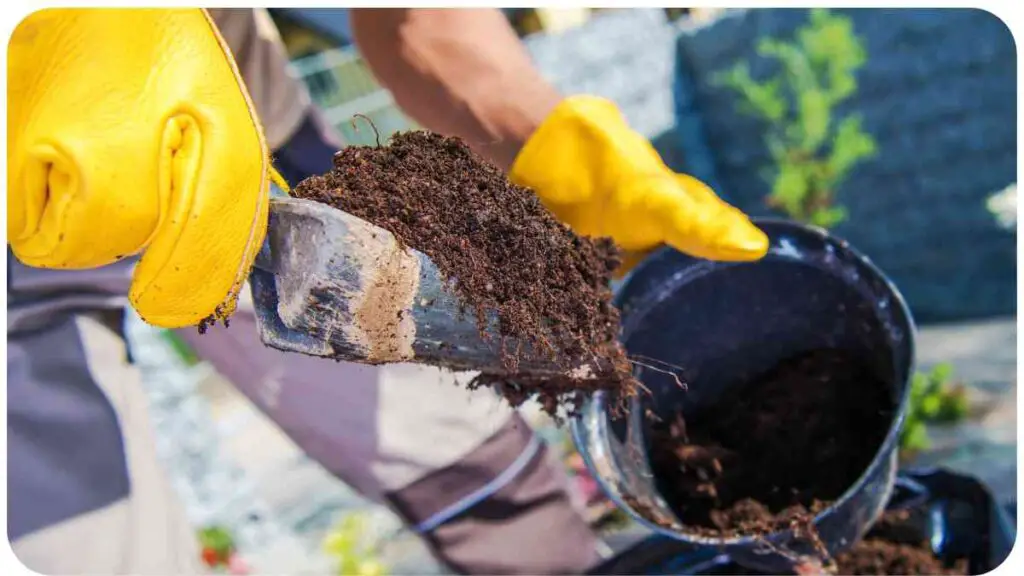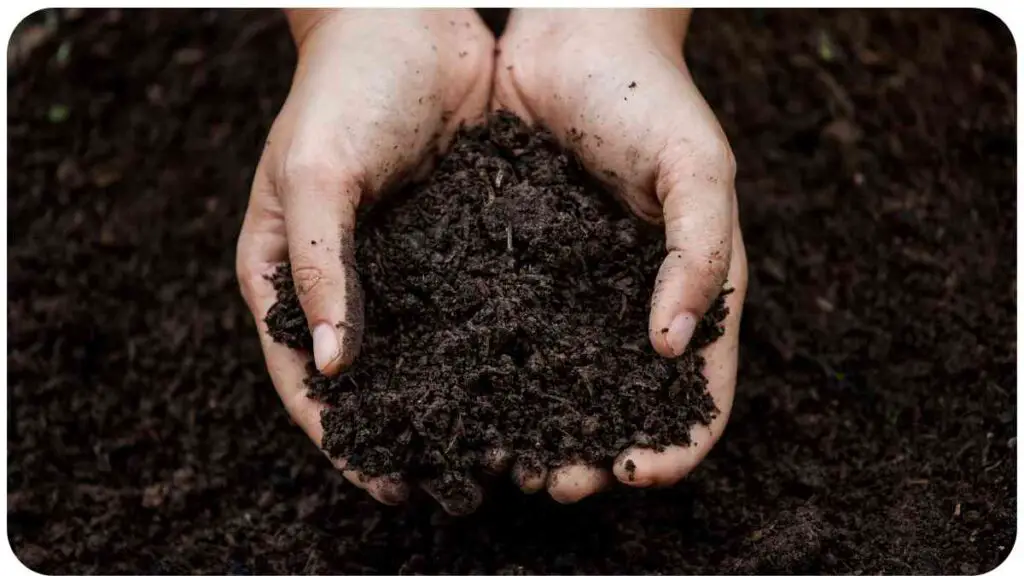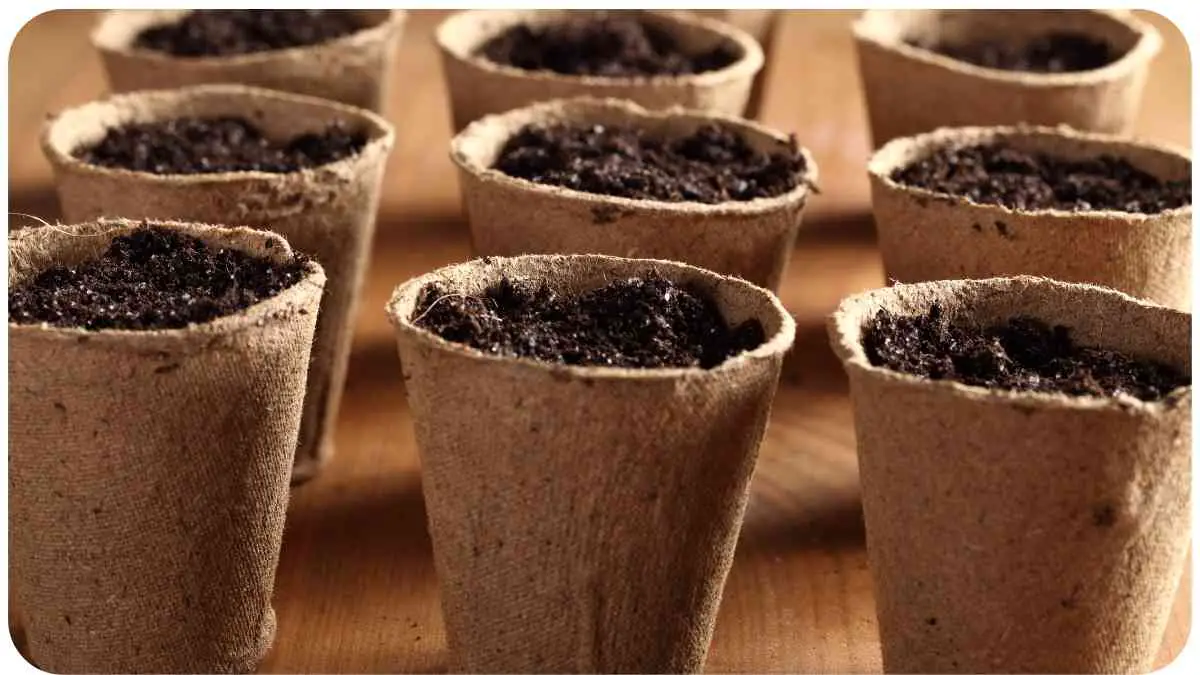If you’re an avid gardener, you know the value of good soil in nurturing healthy plants. However, over time, potting soil can become depleted of nutrients and lose its structure, impacting plant growth.
But fear not! In this guide, we’ll explore how to breathe new life into old potting soil, saving you money and ensuring your plants thrive.
| Takeaways |
|---|
| 1. Regenerating old potting soil is a cost-effective and sustainable practice for maintaining healthy plants. |
| 2. Understanding the signs of soil deterioration, such as compaction, poor drainage, and nutrient deficiency, is essential for effective regeneration. |
| 3. Methods such as composting, adding amendments, solarization, or sterilization can breathe new life into old potting soil, promoting optimal plant growth. |
| 4. Avoid common mistakes like over-amending, neglecting soil testing, or incomplete sterilization to maximize the effectiveness of soil regeneration efforts. |
| 5. Regular maintenance practices like crop rotation, mulching, and monitoring soil health ensure the longevity of regenerated potting soil and create a thriving garden environment. |
Understanding Old Potting Soil

Before diving into regeneration methods, it’s essential to understand why potting soil deteriorates. Over multiple growing seasons, soil can become compacted, drain poorly, and lose vital nutrients. Microbial activity decreases, and pests or diseases may take hold. Regenerating old potting soil involves rejuvenating its structure and replenishing essential nutrients.
When determining the amount of potting soil needed for a 30-gallon pot, consider factors like plant size and drainage needs. Overfilling can lead to root suffocation, while too little soil can cause instability.” potting soil needed
Table 1: Nutrient Depletion in Old Potting Soil
| Nutrient | Depletion Symptoms |
|---|---|
| Nitrogen | Yellowing leaves, stunted growth |
| Phosphorus | Poor root development, reduced flowering |
| Potassium | Weak stems, increased susceptibility to disease |
| Organic Matter | Soil compaction, decreased water retention |
Signs Your Potting Soil Needs Regeneration
Identifying when your potting soil needs regeneration is crucial for maintaining healthy plants. Look out for these telltale signs:
- Compaction: Soil becomes dense and hard, hindering root growth and water absorption.
- Poor Drainage: Excess water accumulates, leading to root rot and nutrient leaching.
- Nutrient Deficiency: Yellowing leaves, stunted growth, and reduced flowering indicate depleted soil nutrients.
- Pest Infestation: Presence of pests like fungus gnats or root aphids signals unhealthy soil conditions.
- Disease Outbreaks: Soil-borne diseases such as damping-off or powdery mildew may occur more frequently.
By recognizing these symptoms early, you can take proactive steps to regenerate your potting soil and prevent further damage to your plants.
Methods to Regenerate Old Potting Soil
Method 1: Composting
Composting is a natural way to enrich and revitalize potting soil. By adding organic matter such as kitchen scraps, yard waste, and dried leaves to your compost bin, you create a nutrient-rich amendment for your soil. Incorporating compost into old potting soil improves its structure, increases microbial activity, and enhances nutrient availability.
Regularly replacing potting soil is essential to maintain plant health and prevent nutrient depletion. By understanding the signs of soil degradation and following proper guidelines, you can ensure optimal growing conditions for your plants.” replacing potting soil
Table 2: Composting Guide
| Material | What to Include | What to Avoid |
|---|---|---|
| Kitchen Scraps | Fruit and vegetable peels, coffee grounds | Meat, dairy, oily foods |
| Yard Waste | Grass clippings, leaves, small branches | Diseased or pest-infested plants |
| Brown Matter | Shredded newspaper, cardboard, straw | Glossy or colored paper |
| Green Matter | Fresh plant trimmings, weeds | Invasive or herbicide-treated plants |
Method 2: Adding Amendments
Amendments are substances added to soil to improve its physical and chemical properties. Common amendments include:
- Compost: Rich in organic matter and beneficial microbes, compost enhances soil structure and fertility.
- Peat Moss: Improves moisture retention and aeration, ideal for lightening heavy soils.
- Perlite or Vermiculite: Lightweight minerals that enhance drainage and prevent soil compaction.
- Worm Castings: Nutrient-rich waste produced by earthworms, promoting healthy plant growth.
When incorporating amendments into old potting soil, ensure thorough mixing to distribute nutrients evenly and avoid creating nutrient hotspots.
Table 3: Popular Soil Amendments
| Amendment | Benefits | Application Rate |
|---|---|---|
| Compost | Enriches soil, enhances microbial activity | 20-30% of total soil volume |
| Peat Moss | Improves moisture retention, aids in aeration | 10-20% of total soil volume |
| Perlite | Enhances drainage, prevents soil compaction | 10-20% of total soil volume |
| Vermiculite | Improves water retention, adds nutrients | 10-20% of total soil volume |
| Worm Castings | Provides nutrients, promotes soil structure | 5-10% of total soil volume |
Method 3: Solarization
Solarization is a technique that uses sunlight to heat the soil and kill pests, pathogens, and weed seeds. Here’s how to solarize your old potting soil:
- Prepare the Soil: Water the soil thoroughly to ensure it’s moist but not waterlogged.
- Cover with Plastic: Spread a clear plastic tarp over the soil, ensuring it’s tightly sealed around the edges.
- Harness the Sun: Leave the plastic in place for 4-6 weeks during the hottest part of the year, allowing the sun’s heat to penetrate and sterilize the soil.
- Monitor Progress: Check the soil temperature regularly using a thermometer to ensure it reaches at least 120°F (49°C) for effective solarization.
Solarization not only rejuvenates old potting soil but also helps control pests and diseases, reducing the risk of future infestations.
Knowing how to properly replace potting soil is crucial for sustaining healthy plants. From removing old soil to replenishing with fresh mix, following step-by-step instructions ensures your plants receive the nutrients they need for robust growth.” properly replace potting soil
Method 4: Sterilization
Sterilization is another option for revitalizing old potting soil, particularly if you suspect it’s contaminated with harmful pathogens or weed seeds. There are several methods of sterilization, including:
- Steam Sterilization: Using a soil sterilizer or steam machine to heat soil to high temperatures, killing pathogens and pests.
- Microwave Sterilization: Microwaving small batches of soil in a microwave-safe container to eliminate microbes and weed seeds.
- Chemical Sterilization: Treating soil with chemicals such as hydrogen peroxide or bleach to disinfect and kill pathogens.
When sterilizing soil, follow manufacturer instructions carefully and take appropriate safety precautions to protect yourself and the environment.
Choosing the Right Method for Your Soil

Each method of soil regeneration has its advantages and considerations. Consider factors such as soil condition, budget, time constraints, and environmental impact when selecting the most suitable method for your potting soil.
Table 4: Choosing the Right Regeneration Method
| Factors to Consider | Composting | Adding Amendments | Solarization | Sterilization |
|---|---|---|---|---|
| Soil Condition | Improves structure and fertility | Enhances nutrient availability | Kills pests, pathogens, and weeds | Eliminates pathogens and weed seeds |
| Budget | Low-cost | Moderate-cost | Low-cost, but requires sunlight | Variable-cost depending on method |
| Time Constraints | Requires time for decomposition | Immediate impact, but may require multiple applications | 4-6 weeks for solarization process | Variable depending on method |
| Environmental Impact | Eco-friendly | Sustainable | Energy-intensive, potential plastic waste | Chemical use may have environmental impact |
Common Mistakes to Avoid
While regenerating old potting soil, it’s essential to steer clear of these common pitfalls:
- Over-Amending: Adding too much compost or amendments can alter soil pH and nutrient levels, leading to imbalances.
- Ignoring Drainage: Poorly drained soil can suffocate plant roots and promote fungal diseases. Ensure adequate drainage by incorporating perlite or vermiculite.
- Skipping Soil Testing: Without knowing your soil’s nutrient levels and pH, you may inadvertently worsen imbalances by adding amendments blindly. Conduct a soil test before regeneration.
- Incomplete Sterilization: If sterilizing soil, ensure thorough heating to eliminate all pathogens and weed seeds. Incomplete sterilization can lead to recurring pest or disease problems.
- Neglecting Regular Maintenance: Soil regeneration is not a one-time task. Regularly monitor soil health, amend as needed, and practice good garden hygiene to prevent issues from recurring.
By avoiding these mistakes, you can maximize the effectiveness of soil regeneration efforts and promote optimal plant growth.
Selecting the best potting mix is vital for the health and vitality of your flowers. Consider factors like drainage, nutrient content, and pH balance to provide optimal growing conditions and encourage vibrant blooms in your garden.” best potting mix
Tips for Maintaining Healthy Soil

Once you’ve regenerated your potting soil, follow these tips to maintain its health and vitality:
- Rotate Crops: Avoid planting the same crops in the same soil year after year to prevent nutrient depletion and disease buildup.
- Mulch: Apply a layer of organic mulch to conserve moisture, suppress weeds, and gradually enrich the soil as it decomposes.
- Practice Crop Rotation: Rotate crops annually to prevent nutrient depletion and reduce the risk of soil-borne diseases.
- Monitor pH and Nutrient Levels: Regularly test soil pH and nutrient levels to ensure they’re within optimal ranges for plant growth.
- Promote Soil Biology: Encourage beneficial soil organisms such as earthworms and mycorrhizal fungi by minimizing chemical inputs and maintaining organic matter levels.
By implementing these practices, you can prolong the life of your regenerated potting soil and create a healthy growing environment for your plants.
Identifying signs of bad potting mix is essential for maintaining healthy plants. Common indicators include foul odors, mold growth, and poor drainage. By recognizing these issues early on, you can take steps to rejuvenate your soil or replace it as needed.” signs of bad potting mix
Conclusion
Regenerating old potting soil is a cost-effective and sustainable way to maintain healthy plants and reduce waste. By understanding the signs of soil deterioration and implementing appropriate regeneration methods, you can breathe new life into your garden beds and containers.
Whether through composting, adding amendments, solarization, or sterilization, there’s a method suitable for every gardener’s needs. Remember to avoid common mistakes, monitor soil health regularly, and follow good gardening practices to ensure long-term success. With rejuvenated soil, your plants will thrive, and your garden will flourish for seasons to come.
Further Reading
- Recharge Old Soil – Gardeners.com: A comprehensive guide on rejuvenating old soil with practical tips and techniques.
- Frugal Gardening: Reusing Old Potting Mix – The Micro Gardener: Learn frugal gardening strategies for reusing and revitalizing old potting mix to save money and reduce waste.
- Reviving Old Potting Soil – Rosy Soil: Discover expert insights and methods for reviving old potting soil to create healthy growing conditions for your plants.
FAQs
How often should I regenerate old potting soil?
Regenerating old potting soil depends on factors such as soil type, plant type, and environmental conditions. As a general rule, aim to rejuvenate soil annually or whenever you notice signs of deterioration.
Can I reuse old potting soil?
Yes, old potting soil can be reused with proper regeneration techniques. By replenishing nutrients, improving soil structure, and sterilizing if necessary, you can breathe new life into old soil and create a healthy growing environment for your plants.
What are the benefits of composting for soil regeneration?
Composting is an excellent way to regenerate old potting soil as it adds organic matter, enhances soil structure, and promotes beneficial microbial activity. Additionally, composting recycles kitchen and yard waste, reducing environmental impact and saving money on soil amendments.
How can I test if my potting soil needs regeneration?
You can test your potting soil’s health by observing plant growth, checking soil moisture and drainage, and conducting a soil test to analyze nutrient levels and pH. Signs of compacted soil, poor drainage, nutrient deficiency, or pest infestations indicate the need for regeneration.
What are the risks of neglecting soil regeneration?
Neglecting soil regeneration can lead to poor plant growth, increased susceptibility to pests and diseases, and reduced yields. Over time, depleted soil may become compacted, drain poorly, and harbor harmful pathogens, impacting the overall health of your garden. Regular regeneration helps maintain soil fertility and supports vibrant plant growth.

For 15 years, Hellen James has worked in the gardening industry as an expert and landscape designer. During her career, she has worked for a variety of businesses that specialize in landscaping and gardening from small firms to large corporations.

